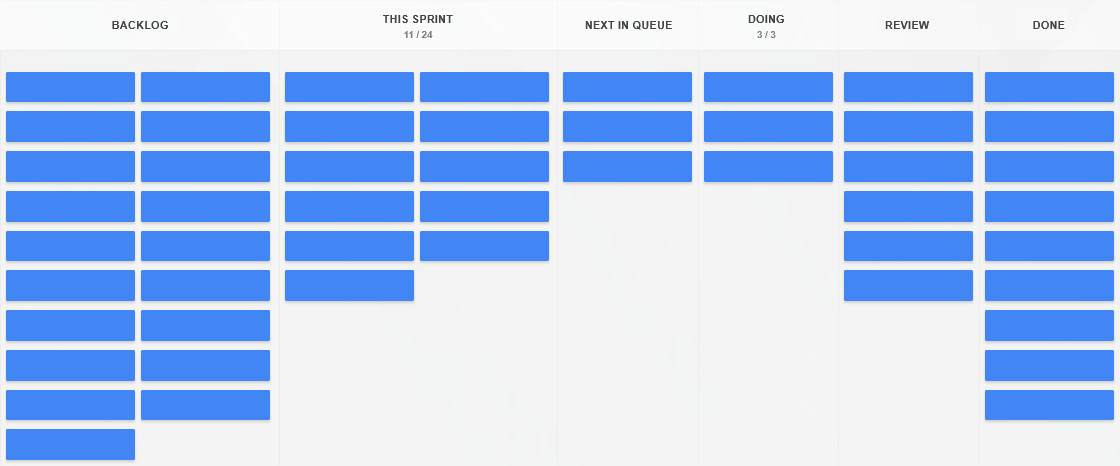Blog
A Comparative Breakdown of Kanban and Scrum: Choosing the Right Fit for Your Workflow03 Jun 2025

Agile project management is dominated by two methodologies: Scrum and Kanban. Both aim to improve productivity and collaboration while increasing work visibility. Still, despite sharing agile DNA, they operate on fundamentally different philosophies. Therefore, your team's choice between the two should not be made based on trends or superficial familiarity, but on your work understanding —how your team starts, processes, and completes tasks.
This article will dissect the two frameworks, not as rival factions but as tools with distinct use cases, strengths, and weaknesses.
The difference between framework and flow
Scrum is a prescriptive framework: it defines a set process with strict roles (Product Owner, Scrum Master, Development Team), fixed-length iterations (sprints—typically 2–4 weeks), and a sequence of rituals (sprint planning, daily stand-ups, reviews, and retrospectives). This approach thrives on regularity and requires disciplined planning and a firm team commitment to completing planned work for each iteration. The goal of using Scrum is a potentially shippable product increment at the end of every cycle.

Kanban, by contrast, is a pull-based system focused on workflow visualization and continuous delivery. There aren't mandatory roles, timeboxes, or ceremonies. Work items move through a visual board—usually columns representing process steps—at their own pace, but constrained by Work In Progress (WIP) limits. Instead of planning work into iterations, Kanban promotes real-time prioritization and delivery based on the capacity and demand present.

When is workflow structure of benefit?
Scrum is strongest when work can be broken down into meaningful functionality increments. Think feature development, iterative product design, or broad projects in which stakeholder feedback is frequent and essential. The timeboxed sprints promote focus, reduce context switching, and provide a solid rhythm. This rhythm is especially useful for teams that benefit from regular checkpoints and psychological pacing.

However, this kind of structure can cause friction in settings where priorities shift rapidly, or where the effort required for specific tasks is unpredictable or hard to estimate. In those contexts, Scrum's rigidity may become more akin to an overhead than guidance.
By distancing itself from the concept of a sprint, Kanban is more accommodating to teams dealing with reactive work—support desks, IT operations, or content production. If work arrives unexpectedly or widely varies in size or difficulty, Kanban's flexibility becomes invaluable. The focus on limiting WIP and improving cycle time (how long a task takes from start to finish) encourages flow efficiency and responsiveness, rather than batch delivery.

Metrics that matter
Scrum heavily relies on velocity—a measure of how much work a team can complete in a sprint, usually tracked with story points. While useful for long-term planning, it can easily be gamed or misunderstood, particularly in teams new to estimation.
Kanban leans on lead time, cycle time, and throughput. These non-abstract metrics measure exactly how long things take and how many items get done, making them directly actionable for identifying bottlenecks or inefficiencies within the system.
For teams seeking predictability through empirical data, the flow metrics in Kanban provide a clearer lens into performance than velocity would, as it is often tied more to estimation confidence than real-life productivity.
Change management and maturity levels
Implementing Scrum from scratch requires a deliberate shift in team culture. Adopting its roles and ceremonies can initially be disruptive if the team isn’t used to self-organization or timeboxing. It’s not uncommon for Scrum adoptions to fail due to resistance to these constraints, especially if leadership lacks buy-in or the team is too junior to self-manage.
Kanban, on the other hand, is easy to introduce incrementally, though it will never offer as clear a structure as Scrum. Kanban teams don’t have to change their existing process overnight. Instead, they visualize their current workflow, add WIP limits, and iterate improvements based on the observed flow. For that reason, Kanban is usually the safer choice for teams dipping their toes into agility or working in highly constrained environments where a total overhaul of the process isn’t viable.
Roles and accountability
Scrum clearly defines work ownership. The Product Owner holds the backlog and business value, the Scrum Master ensures process integrity, and the team delivers. Such role clarity can benefit larger organizations or cross-functional teams where responsibilities easily blur.
Kanban is less prescriptive, assuming that roles and responsibilities are already well understood or will emerge through active collaboration. The absence of role enforcement can be liberating in flat organizations but problematic in teams that need external facilitation to keep things moving.
Hybridization and reality checks
While many teams gravitate toward “pure” implementations of a single framework, the reality in most organizations is messier. Hybrid approaches like Scrumban have emerged to combine Scrum’s regular planning cadence with Kanban’s flow optimization. Such hybrids are rarely out-of-the-box solutions—they require thoughtful tailoring, often through trial and error or—at least—much reflection.

What matters more than naming your approach is understanding the forces shaping your team’s work: the standard rate of incoming requests, the predictability of task sizes, the availability of skilled personnel, and stakeholders' expectations.
Ask the right questions to come to a decision
Before selecting Kanban or Scrum, consider the following:
- Is our work predictable enough to be planned for 2–4 weeks ahead?
- Do we face frequent interruptions or priority shifts?
- Do we have the organizational maturity to adopt defined roles and ceremonies?
- Are we optimizing for delivery speed, process predictability, or stakeholder feedback cadence?

Neither Kanban nor Scrum is universally “better”, as they address different complexity types: Scrum organizes around delivery cadence and stakeholder input, while Kanban focuses on flow, adaptability, and system efficiency.
Choosing one—or blending the two—is less about following a template and more about designing a system that respects your team’s real-life constraints, habits, and aspirations. The value lies in the agility to adapt and evolve rather than adhering to a fixed methodology for its own sake.
Sign up for a 14-day free trial
to test all the features.
Sign up now and see how we can help
your organization deliver exceptional results.